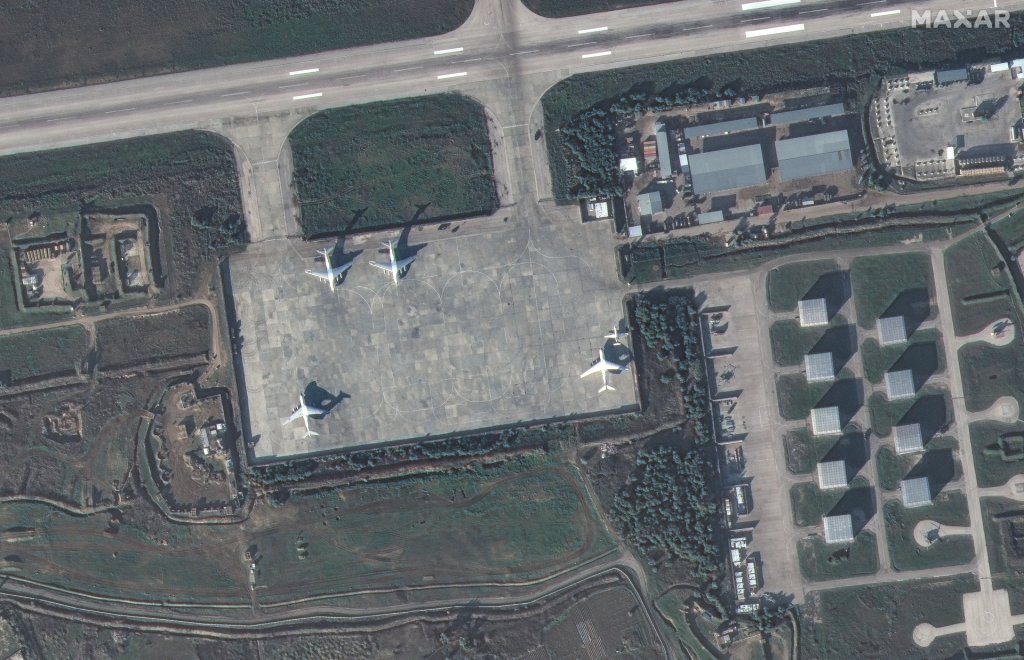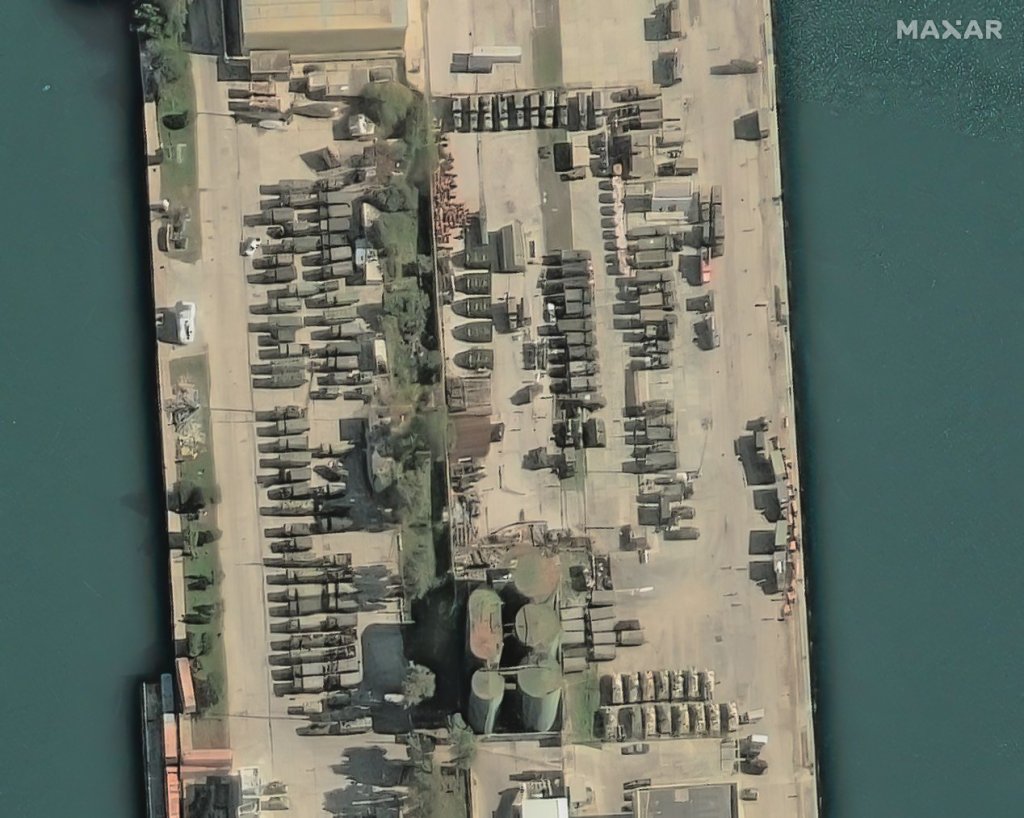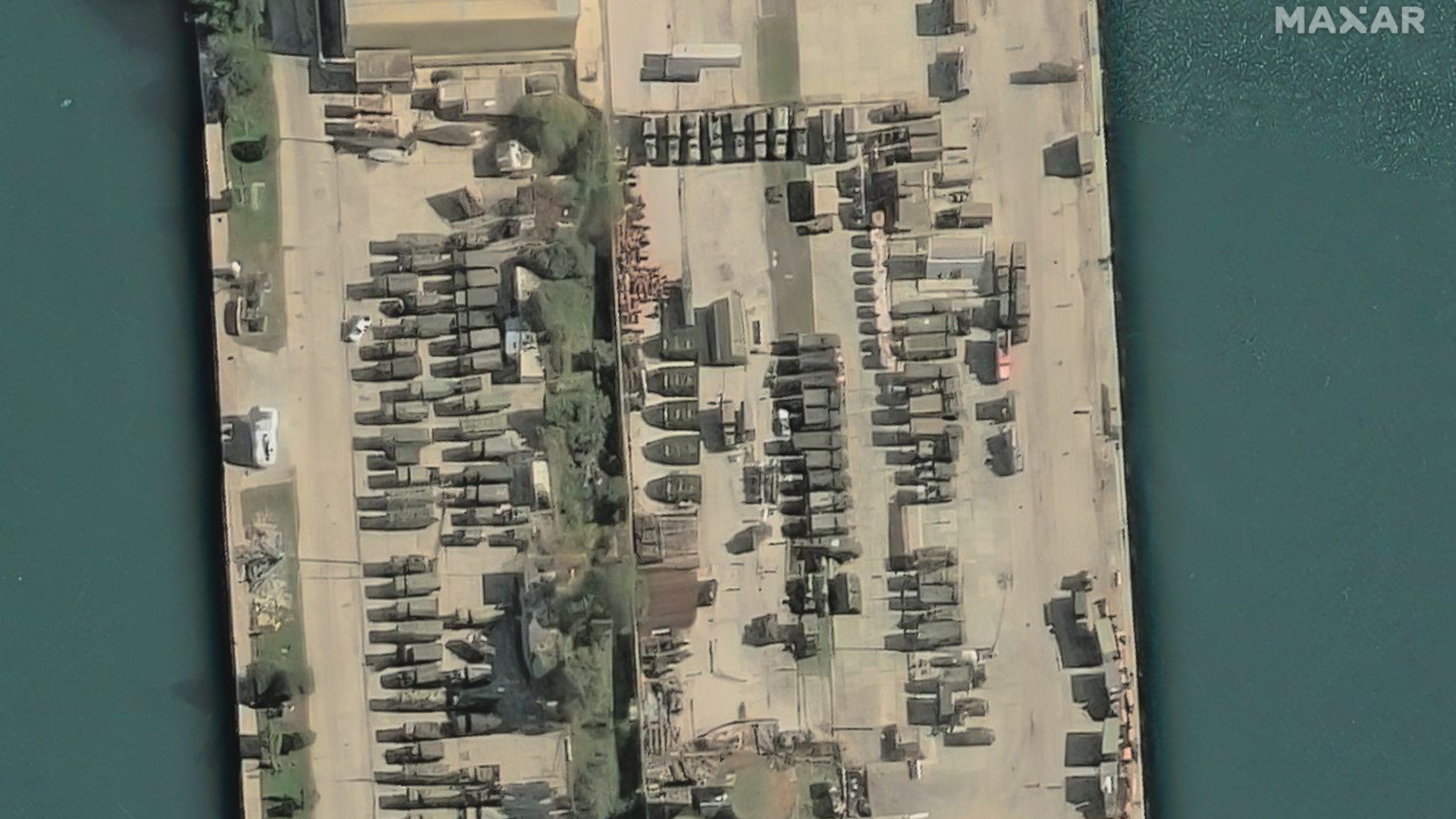New satellite imagery shows large numbers of Russian vehicles and other materiel amassed at its Khmeimim Air Base and Tartus naval base in Syria. The active withdrawal of forces from Khmeimim is also continuing. This all comes despite continued insistence from authorities in Moscow that they are still looking to strike a deal to keep these highly strategic and prized facilities following the fall of the Assad regime.
The War Zone obtained the new imagery of both Khmeimim and Tartus, which was taken today, from Maxar. The company also provided an additional image of Khmeimim from Dec. 15 that highlights the significant departure of Russian forces from the base even by that point.
The latest image of Khmeimim, seen below, shows dozens of vehicles and other equipment arranged in rows on an open apron at the northwest corner of the base, along with an Il-76 Candid cargo aircraft. Assets are often arranged in this way on the tarmac at air bases ahead of their loading onto aircraft. Two smaller An-26 Curl turboprop transport aircraft, as well as a jet-powered An-72 Coaler, are also seen in nearby revetments.

Russian forces have already been withdrawing from Khmeimim. This is now further underscored by Maxar’s Dec. 15 image of a portion of the northeastern end base, which notably shows the S-400 surface-to-air missile system site that had been deployed there for years, that has now been completely dismantled. Work to withdraw to the S-400, as well as other air defense assets, had already been observed at Khmeimim.

Four Il-76s and a Yak-40 small airliner are also seen on an open apron there. One of the Il-76s, as well as the Yak-40, belong to Syrian Airlines and there is the possibility this Candid is the one that went missing in the final chaotic moments of Assad’s regime, which you can read more about here. There are also multiple helicopters visible, some of which appear to be missing rotor blades. This could be a sign that they are being broken down to be loaded into transport planes.
At Tartus, the Maxar imagery shows dozens of vehicles and other equipment clustered at the end of one of the piers. Again, this could point to impending plans to withdraw those forces.



What is seen in the imagery is also in line with videos taken on the ground over the past week or so, which shows Russian units converging on the naval base.
Russian warships left Tartus days ago, but look to be continuing to hold positions just off shore rather than departing the area entirely. Russian cargo ships Sparta IV and Ursa Major, which have made trips to Syria in the past, were seen headed south through the English Channel yesterday together with a Russian Navy Steregushchiy class corvette. A Ropucha class landing ship was also seen departing the Baltic last week and the Ivan Gren, another amphibious warfare ship, may be headed in the same general direction. The possibility has been raised that all these vessels are now headed to Tartus to support a large withdrawal effort.
“In Syria, primarily, what we’re seeing is a consolidation of Russian capabilities,” a senior military official told reporters, including from The War Zone, at a Tuesday afternoon briefing. “They have ceased flight operations over the country.”
“It appears to us that they’re [the Russians] taking the steps that would be necessary if they were planning to retrograde their forces from there,” the official added. “We don’t know if they’ve reached the decision to do that, or if they are in discussions on whether they need to do that or not, but that force consolidation that would enable them to depart has certainly happened.”
From “a naval perspective, they have sent their fleet that was in Tartus out into the eastern Mediterranean,” the official continued. “It’s not in port in Tartus, or wasn’t the last time I looked. And so, again, it looks like they’re setting conditions to depart. And as I mentioned, they have ceased military operations there as best we can tell.”

Though there is no doubt that Russia is significantly drawing down its military presence in Syria, as the senior defense official noted, it still remains unclear whether it plans to withdraw from Khmeimim and Tartus for good. There continue to be reports that Russian authorities are negotiating with representatives of the new rebel-led transitional government about the future of the bases. Officials in Moscow have consistently insisted that no final decision on the status of the facilities has been made.
There are also unconfirmed reports that the Russian military may have been ordered to leave entirely within a month and that the Kremlin could now be looking to expand its presence in Libya as an alternative. As The War Zone has continued to stress, being ejected from Khmeimim and Tartus would be a huge loss for the Kremlin with ramifications extending well beyond Syria. The Russians have poured significant resources into expanding these bases, which Assad had essentially gifted to them through a 49-year ‘lease’ deal in 2017. The facilities offer uniquely strategic locations to project air and naval power into the Mediterranean and Africa.
Any talks the Russians are having with rebel authorities in Damascus now can only be complicated by Moscow’s instrumental and active role in keeping Assad’s brutal regime in power over the past decade or so. Russian forces were still striking the very same rebels just days before they ousted Assad. The Kremlin also says that it helped Assad flee the country and that they have granted him asylum. Assad has remained out of the public eye for more than a week now.
A report today from Politico says that some members of the European Union are pushing the bloc to actively pressure Syria’s new government to force out the Russians. French authorities re-raised the country’s flag at the embassy in Damascus today, which had been shuttered for the past 12 years, in the latest sign of Western powers looking to reengage post-Assad.
The overall geopolitical situation in Syria remains extremely fluid due to internal and external factors. This includes an Israeli campaign of strikes on former regime military assets and ground intervention in the south, as well as an offensive by Turkish-backed rebels against U.S.-backed Kurdish groups in the north. The U.S. military itself remains a major player in the country, as well.
Earlier today, the head of the U.S.-backed predominantly Kurdish Syrian Democratic Forces (SDF) offered major concessions, including turning the city of Kobani into a demilitarized zone, as part of a proposal to end fighting Turkish-supported groups. He suggested American forces could help enforce such an arrangement.
“As far as Kobani goes, and, you know, the ceasefire discussions between groups that are there and the SDF and others, … that’s something that we’re obviously monitoring closely,” Air Force Maj. Gen. Patrick Ryder, the Pentagon’s top spokesperson, said in response to a question from The War Zone‘s Howard Altman at a routine press conference today. “I think we all have a vested interest in ensuring that groups in the region capitalize on the situation here to enable the people of Syria to be able to have a better life than they did under the Assad regime. But as it relates to the U.S. force presence in Syria, it is focused on the defeat ISIS mission.”
Speaking today from atop Mount Hermon in Syria, Israeli Prime Minister Benjamin Netanyahu also said his country’s forces would continue to occupy a buffer zone in the south “until another arrangement can be found that guarantees Israel’s security.”
What Russia’s future in Syria might look like is still very uncertain, but its military presence is already notably shrinking.
Howard Altman contributed to this story.
Contact the author: joe@twz.com
